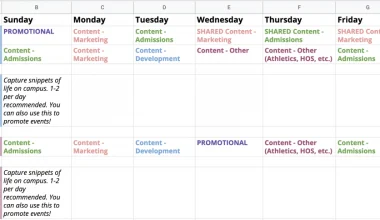When it comes to increasing brand visibility, gaining customer loyalty, and achieving overall business success, there’s a need for strategy and creativity. Strategy and creativity converge to pave the way for business success. To achieve overall business success, you’ll have to engage in strategic marketing planning because it’ll equip you with the knowledge and tools to create a comprehensive and effective marketing plan that drives results. It outlines the pathway for every business’s marketing efforts. It involves setting goals, identifying target audiences, conducting market research, and outlining strategies to achieve those goals.
What Is Marketing Planning?
Marketing planning is the process of developing a strategic approach to promote a product, service, or brand to achieve specific business objectives. It involves setting goals, identifying target audiences, conducting market research, analyzing competitors, defining marketing strategies, and allocating resources to execute those strategies effectively. A well-structured marketing plan helps businesses reach their target customers, increase sales, and build brand awareness.
Strategic Marketing Planning
Strategic marketing planning is a comprehensive and long-term approach to developing a marketing strategy that aligns with the overall business goals and objectives. It involves analyzing the market, understanding customer needs and preferences, assessing competitors, and identifying opportunities and challenges. The process includes setting clear and measurable marketing objectives, formulating strategies to achieve those objectives, and defining specific tactics and actions to implement the strategies effectively.
A strategic market plan typically includes elements such as target market analysis, positioning, pricing strategy, promotional activities, distribution channels, and budget allocation. The plan provides a roadmap for the marketing team to follow and serves as a guide to making informed decisions and adjustments based on market dynamics and performance metrics.
The ultimate goal of strategic market planning is to gain a competitive advantage, maximize customer value, and achieve sustainable business growth in the long run. It is an essential process for businesses to stay relevant, adapt to changes in the market, and capitalize on emerging opportunities. Strategic market planning helps businesses make informed decisions, maximize their marketing efforts, and stay ahead of the competition in the long run.
Steps to Strategic Marketing Planning
The following are the steps in strategic marketing planning:
- Market Analysis: Understanding the industry, target market, and consumer needs through market research and data analysis
- Setting Objectives: Establishing clear and measurable marketing goals aligned with the overall business objectives
- Identifying the Target Audience: Defining the specific segment of customers the company wants to reach and influence.
- Competitive Analysis: Assessing competitors’ strengths and weaknesses to identify opportunities and threats
- Developing Marketing Strategies: Creating plans and tactics to differentiate the company’s offerings, position the brand, and reach the target audience effectively.
- Budget Allocation: Allocating resources wisely to support marketing initiatives and achieve the set objectives
- Implementation: Executing the marketing strategies and closely monitoring the progress
- Evaluation and Adjustment: Continuously evaluate the marketing efforts’ performance and make adjustments based on the results to ensure success.
Examples of Marketing Planning
The following are some examples of marketing planning:
#1. Product Launch Campaign
Developing a detailed plan to introduce a new product to the market, including target audience analysis, messaging strategy, promotional channels, and a launch timeline.
#2. Seasonal Promotions
Creating marketing plans for seasonal events or holidays, outlining special offers, discounts, and promotional activities to capitalize on increased consumer demand.
#3. Content Marketing Strategy
Formulating a content marketing plan that includes content creation, distribution channels, SEO optimization, and social media promotion to attract and engage the target audience.
Designing a social media marketing strategy to increase brand awareness, audience engagement, and lead generation, outlining the content calendar and platform-specific tactics.
#5. Email Marketing Campaign
Planning an email marketing campaign with targeted email lists, personalized content, and specific goals such as driving sales, increasing website traffic, or nurturing leads
#6. Event Promotion
Creating a marketing plan for a company event or conference, including pre-event promotion, on-site activities, and post-event follow-up strategies
#7. Customer Retention Plan
Developing a strategy to retain existing customers through loyalty programs, personalized offers, and customer engagement initiatives
#8. Competitor Analysis
Conducting market research and competitor analysis to identify strengths and weaknesses, and then devising a plan to position the brand effectively in the market.
#9. Influencer Marketing Campaign
Crafting a plan to collaborate with influencers and leverage their reach to promote products or services to a specific target audience
#10. Digital Advertising Strategy
Designing a comprehensive plan for online advertising, including pay-per-click (PPC) campaigns, display ads, and remarketing efforts to boost online visibility and conversions.
Types of Marketing Plans
There are several types of marketing plans, each catering to different business objectives and strategies. Each marketing plan should be tailored to the specific goals and needs of the business, considering the target market, budget, and desired outcomes. The following are some common types:
- Comprehensive Marketing Plan: An all-encompassing plan that covers various marketing aspects and goals for the entire organization
- Digital Marketing Plan: Focused on online channels such as social media, email marketing, SEO, and digital advertising.
- Content Marketing Plan: Emphasizes creating and distributing valuable content to attract and engage the target audience.
- Product Launch Marketing Plan: Specifically designed for introducing new products or services to the market.
- Seasonal Marketing Plan: Geared towards capitalizing on specific seasons or events to boost sales and promotions.
- Social Media Marketing Plan: Centers on strategies to leverage social media platforms effectively.
- Inbound Marketing Plan: Aims to draw customers through valuable content and experiences rather than direct advertising.
- Event Marketing Plan: Focuses on organizing or participating in events to promote products or services.
- Localized Marketing Plan: Tailored to target specific geographical areas or local communities.
How to Write a Marketing Planning
To write a marketing plan, follow these key steps:
- Market Research: Understand your target audience, industry trends, and competitors.
- Set Objectives: Define clear, measurable marketing goals that align with your overall business objectives.
- Develop Strategies: Determine the marketing channels (e.g., social media, email, SEO) and tactics you’ll use to reach your audience and achieve your goals.
- Budget Allocation: Allocate resources and budget to each marketing activity based on its potential ROI.
- Create a Timeline: Set a timeline for implementing each marketing activity and achieving milestones.
- Craft Your Message: Develop a compelling and consistent brand message that resonates with your target audience.
- Implement and Monitor: Put your plan into action, and closely monitor the performance of each marketing campaign.
- Analyze Results: Regularly assess the effectiveness of your marketing efforts and make data-driven adjustments as needed.
- Stay Flexible: Be prepared to adapt your plan based on changes in the market or business priorities.
- Review and Refine: Continuously review and refine your marketing plan to optimize its impact.
What Are the 4 C’s of a Marketing Plan?
The 4 C’s of a marketing plan are:
- Customer: Understanding the needs and preferences of the target customers.
- Cost: Determining the pricing strategy that aligns with customer value and market conditions.
- Convenience: Making the product or service easily accessible to the customers.
- Communication: Developing effective ways to reach and engage with the target audience to promote the offering
What Should a Good Marketing Plan Include?
A well-structured marketing plan provides a roadmap for businesses to effectively promote their products or services, gain a competitive advantage, and achieve their marketing objectives. Therefore, a good marketing plan should include the following key components:
- Executive Summary: A brief overview of the marketing plan’s objectives, strategies, and expected outcomes
- Market Analysis: A comprehensive assessment of the market, including industry trends, competitors, and target audience demographics
- SWOT Analysis: An evaluation of the business’s strengths, weaknesses, opportunities, and threats to identify areas for improvement and potential advantages
- Marketing Objectives: Clear and specific goals that the marketing efforts aim to achieve, such as increasing sales, brand awareness, or market share.
- Target Market: A detailed description of the ideal customers and their characteristics to guide marketing strategies
- Marketing Strategies: A well-defined plan outlining the methods and approaches to reach the target audience, promote products or services, and achieve the marketing objectives
- Budget and Resource Allocation: A breakdown of the budget allocated for marketing activities and how resources will be distributed across different marketing channels.
- Marketing Mix (4 P’s): A discussion of the product, price, promotion, and place (distribution) strategies to create a cohesive marketing approach
- Implementation Plan: A timeline and action steps detailing when and how marketing initiatives will be executed.
- Monitoring and Evaluation: Metrics and key performance indicators (KPIs) to measure the success of marketing efforts and strategies to adjust the plan as needed
- Contingency Plan: Anticipated challenges and alternative approaches to address potential obstacles in the marketing process.
- Legal and Ethical Considerations: Ensuring that all marketing activities comply with relevant laws and ethical standards
What Is a Marketing Plan Checklist?
A marketing plan checklist is a comprehensive list of essential items and tasks that should be included in a marketing plan. It serves as a guide to ensure that all critical components are covered and nothing important is overlooked.
What Makes a Good and Effective Marketing Plan?
A good and effective marketing plan possesses several key qualities that contribute to its success. Those qualities are mostly basic concepts of marketing plans. The following are some of what makes a good and effective marketing plan:
- Clear Objectives: A well-defined and measurable set of marketing objectives that align with the overall business goals Specific objectives help guide the marketing efforts and provide a clear direction.
- Comprehensive Market Analysis: Thorough research and analysis of the market, competitors, and target audience. Understanding the market landscape helps identify opportunities and potential challenges.
- Targeted Audience Identification: A deep understanding of the target audience’s needs, preferences, and behaviors. Tailoring marketing strategies to address specific customer segments increases the plan’s effectiveness.
- Focused Strategies: Clear and actionable marketing strategies that outline how the business will reach its target audience, promote products/services, and differentiate from competitors.
- Budget Allocation: A well-structured budget allocates resources appropriately to each marketing initiative, ensuring that funds are spent wisely.
- Key Performance Indicators (KPIs): Establishing relevant metrics to measure the success of the marketing plan Regularly tracking KPIs helps identify areas for improvement and allows for adjustments if needed.
- Digital and Traditional Mix: A balanced mix of digital and traditional marketing channels, as well as utilizing the most appropriate platforms for reaching the target audience.
- Creative and Compelling Content: Engaging and valuable content that resonates with the target audience builds brand credibility and fosters customer loyalty.
- Risk Assessment and Contingency Plan: Identifying potential risks and challenges and having a contingency plan to address them if they arise
- Regular Evaluation and Review: Consistently monitor and evaluate the effectiveness of the marketing strategies and make data-driven adjustments as necessary.
What Is a Marketing Template?
A marketing template is a pre-designed framework or layout that helps marketers create consistent and professional-looking marketing materials. It could be used for various purposes, such as social media posts, email campaigns, flyers, brochures, or presentations. Templates usually include placeholders for text, images, and branding elements, making it easier to customize and streamline the marketing process. They save time and effort while maintaining a cohesive visual identity across different marketing materials.
What Is the Most Important Part of a Marketing Plan?
The most important part of a marketing plan is defining a clear and well-researched target audience. Understanding who your customers are and what they need will help you tailor your marketing strategies effectively.
Relates Articles
- Everything You Need to Know About Marketing Objectives
- MARKETING STRATEGY: What It Is and How to Create One
- WHAT IS CUSTOMER SUPPORT: Definition, Types, and Benefits
- SOCIAL MEDIA CAMPAIGNS: The Ultimate Guide to Social Media Marketing Campaigns
- BUSINESS DEVELOPMENT: Meaning, Centres, Salary.& Unique Ideas






